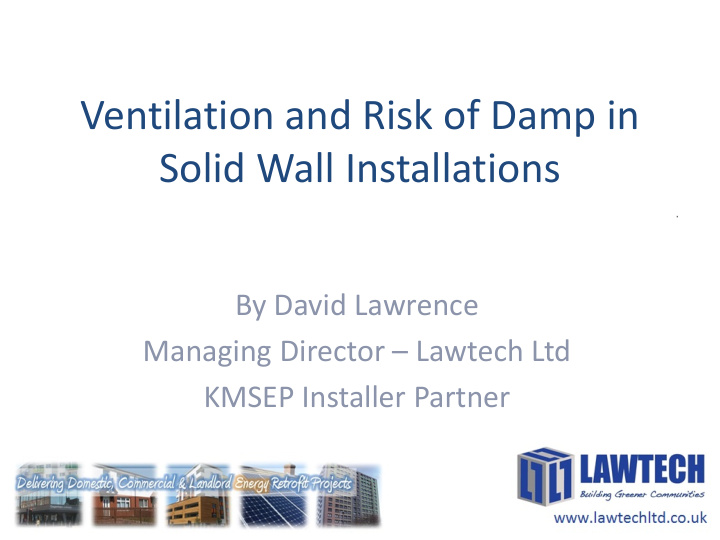



Ventilation and Risk of Damp in Solid Wall Installations By David Lawrence Managing Director – Lawtech Ltd KMSEP Installer Partner
Introduction • 20 Years’ Industry Experience • Managing Director of EWI Specialist Installer • Chairman Solid Wall Council of NIA (National Insulation Association) • Board member of SWIGA (Solid Wall Insulation Guarantee Agency)
Effective Ventilation • Effective ventilation in buildings provides a safe and comfortable environment for the occupants. • Effective ventilation on an insulated building, especially that of Solid Wall Construction, is paramount. • With energy efficiency improvements to a building, passive vapour dissipation and the adventitious ventilation on a typical solid wall construction is reduced; therefore changes in the ventilation and occupants’ behaviour are needed. • Basic precautions and maintenance can significantly reduce problems caused by condensation and inadequate ventilation.
Insufficient Ventilation • The risks and causes are often misunderstood. • We support Kent in ensuring this message is understood. “Thermal insulation, heating and ventilation should be considered as part of a total design, which takes into account all heat gains and losses.” * *BRE REPORT Thermal Insulation
Insufficient Ventilation – The Risks Failure to Ventilate can lead to: • unsatisfactory internal conditions • condensation and mould • inefficient use of energy due to: – overheating – need to use mechanical cooling.
Insufficient Ventilation – The Risks
Insufficient Ventilation – The Risks
Insufficient Ventilation – The Risks
Insufficient Ventilation – The Risks Damp and mould growth includes threats to physical and mental health from: • House dust mites; • Mould or • Fungal growth.
Insufficient Ventilation – The Risks Health risks include: Breathing difficulties – caused by house dust mite and • mould; Depression and anxiety – because of the conditions; • Asthma, rhinitus, etc; and • Fungal infection – which could affect people taking • treatment for cancer.
Insufficient Ventilation – The Effect “Condensation can occur on surfaces within the construction if water vapour from inside the building is unable to permeate through the external insulation system or be ventilated safely away.”* *BRE REPORT Thermal Insulation
www.buildingconservation.com *
Insufficient Ventilation – The Causes • Trickle vents not installed or blocked by curtains, air bricks being blocked or not used resulting in insufficient background ventilation . • Windows not being opened to allow for trickle or purge ventilation. • Fan assisted mechanical ventilation not installed or not effective in ‘wet’ rooms such as bathrooms and kitchens. • Inappropriate heating regimes that can lead to large temperature changes and consequential condensation.
Insufficient Ventilation – The Causes • Modern living styles that generate large quantities of water vapour (cooking, showering, washing, air drying of laundry in closed rooms). • Piecemeal thermal insulation can isolate inadequately insulated components; this might exacerbate condensation. • Thermally efficient external walls might result in previously unaffected items such as windows, doors and surrounds attracting condensation.
Insufficient Ventilation – The Causes • Poor, piecemeal or ill thought through Retrofit
How to Avoid The Issues • Condensation risk analysis. • Management of ventilation within the building. • Controlling moisture laden air. • Internal surfaces maintained above dew point temperature. • Adopting appropriate heating regimes. • Education. • Behavioural Change.
Further Issues Around Damp • Existing dampness issues should be remedied prior to installation of EWI. • The cause of Damp / Condensation should be identified before embarking on remedial works. • As far as practicable treat the cause not the symptoms. • Cladding design should be tailored to suit the circumstances. • Some EWI systems have greater vapour diffusion rates than others and can allow a building to “breathe”. • Additional background (passive) or mechanical (active) ventilation may be needed as part of an EWI scheme.
Further Reading: BRE Report: Thermal insulation: avoiding risks (2 nd Edition) • http://www.english-heritage.org.uk/publications/external-wall-insulation- • traditional-buildings/ http://www.1stassociated.co.uk/condensation-cold-bridging.asp • http://www.1stassociated.co.uk/articles/condensation-mould-air- • movement-in-home.asp http://www.buildingconservation.com/articles/condensation/condensation. • htm
Recommend
More recommend